Ultimate Guide to Baby Sleep Training
One of the most asked questions our postpartum doulas and newborn caregivers receive is if we can help newborns get on a routine, and infants sleeping through the night. It’s totally normal that parents crave a predictable schedule when their babies arrive! And there are a lot of right answers when it comes to caring for infants. We want baby sleep solutions to be accessible to all, so we created The Ultimate Guide to Baby Sleep Training.
Need to get straight to the plan? TL;DR!
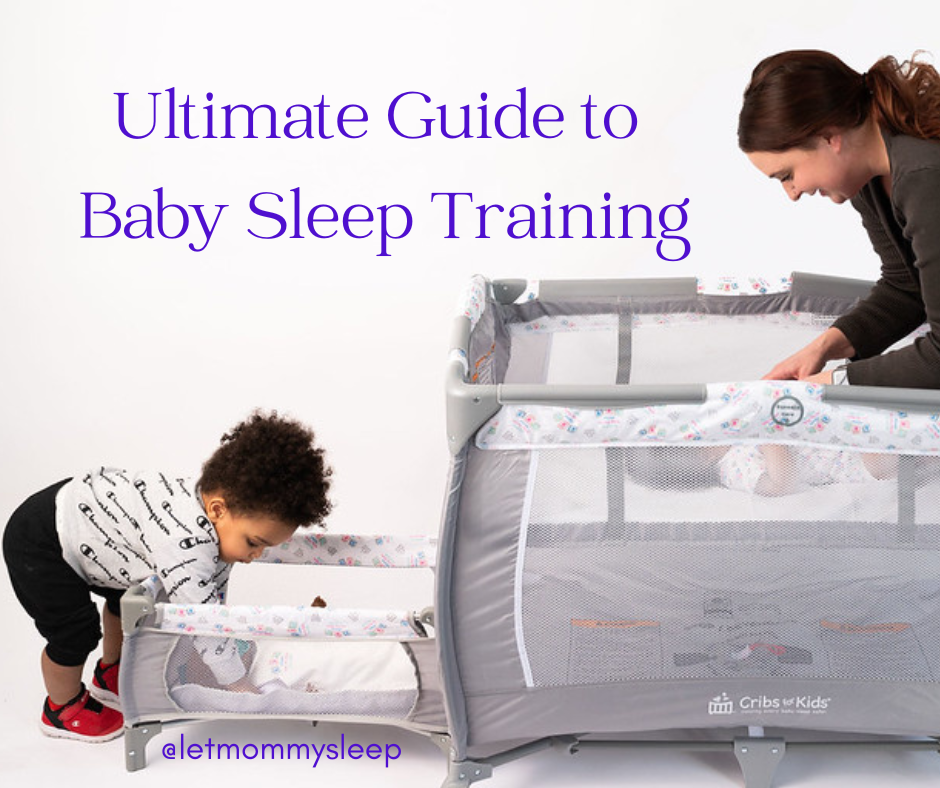
Should We Sleep Train?
For this blog, we’re defining sleep training as sleeping through the night for at least 6 hours without needing to feed, and without needing unnecessary intervention. Sleep training baby is such a hot topic with strong opinions on both sides. The reason for this is because both sides are right! YES – you should comfort your baby and help them sleep. But ALSO YES- it’s correct for your baby to learn to sleep through the night independently if that’s best for your family! In fact, maternal mood scales statistically significantly improved when moms and dads get sleep.
In other words, in a time where many of us don’t have loved ones to help care for our little children, we have to be our own little Village. This means using tools like sleep training to help the whole family function in a healthy way.
Managing Expectations
When Should I Start Sleep Training my Infant?
Every baby is different of course but in general, 4 months and 14 pounds is a good time to start sleep training a full term baby. Here’s why:
- because this is usually when baby has physically grown enough to be able to skip nighttime feeds. In other words, their stomach is big enough to hold enough calories to keep them feeling fuller, longer.
- they’ve developed the hormone melatonin which induces sleep.
Yes, we all have that friend whose child started sleeping through the night earlier than 16 weeks! And you and your pediatrician might agree that sleep training earlier is fine…and that’s okay! You can! We recommend discussing sleep training at your baby’s 4 month well-check because this way you receive validation from the doctor that baby is ready.
What Should Not Happen When Sleep Training:
Newborns Cannot be Sleep Trained – There’s no reason to let a newborn (baby aged 1 -3 months old) cry it out. Crying indicates a need. They don’t learn not to be hungry, uncomfortable or scared.
Here’s what we mean:
- Don’t Leave a Newborn to Cry it Out- Your newborn is not manipulating you. It’s expected that your newborn -who was INSIDE another human for their whole life- cries when they’re not touching you. (It’s not forever, they’ll soon learn it’s okay to be alone!)
- On-demand feeding is Normal -Not having a schedule is fine.
- Hunger – you can’t teach a newborn not to feel hunger. It may seem like you just fed your baby, and you probably did, but frequent feeding of every 2-3 hours is typical and healthy.
- Quick Changes: Our sleep training plans are meant to take about 10-14 days. You can choose to have baby cry-it-out over the course of 2-3 nights (again with the pediatrician’s blessing) but plans outlined below are meant to be a gradual, gentle transition into sleeping through the night independently.
- Rigid Routines: There is no need for a forced schedule unless you were sent home from the hospital with instructions to feed your baby every 2 or 3 hours to help them grow. This is common with preemies, twins and babies born with jaundice. NICU babies who are used to scheduled feedings in the hospital also go home on a schedule. This is fine and often doctor directed but remember that as they grow their feeding schedules may change. If your baby isn’t in this category, don’t worry because their natural clock will emerge.
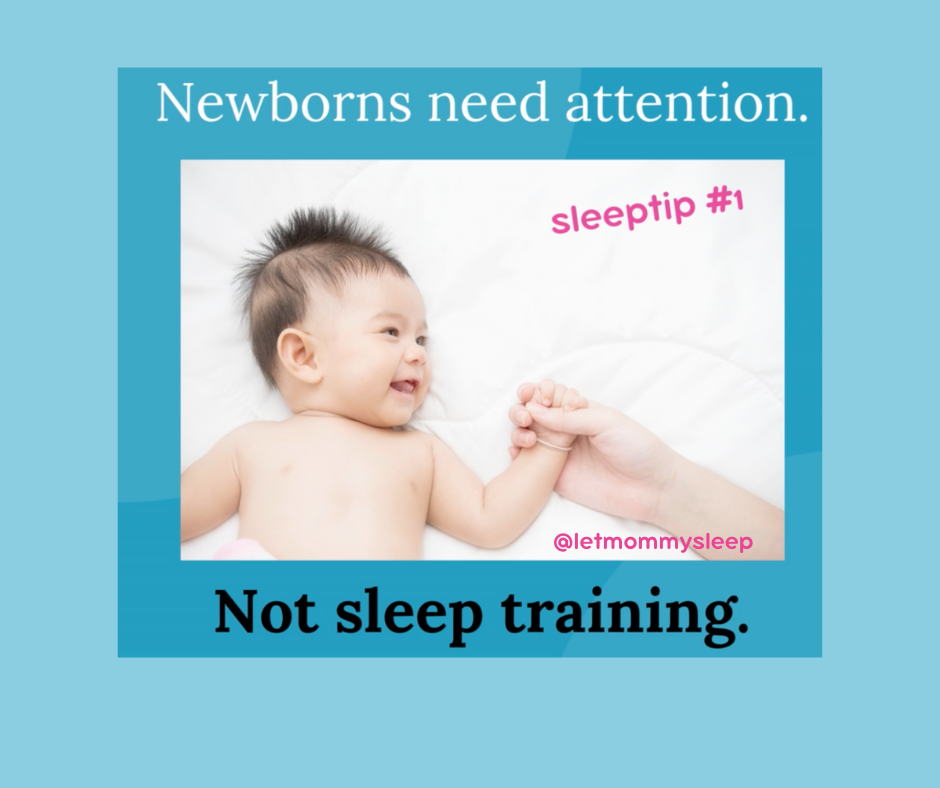
So:
- If it feels like baby sleep or getting on a schedule is a “fight,” it’s time to stop and move on with your day. “It took me 2 hours to get her down!” doesn’t mean getting her down for a nap took 2 hours, it means we just frustrated ourselves until she was actually ready for sleep.
- Baby’s cues trump The Schedule. If your infant is showing signs of hunger at an “unscheduled” time, feed them! Postpartum doula and lactation counselor Jordan reminds us, that on demand feeding is normal and necessary for breastfeeding mothers too. The more nursing is done, the more milk production is stimulated.
- Being flexible helps you both. If baby will “only sleep on you,” that’s okay! You can use a carrier to allow baby to nap during the day if you need to be mobile. Provided that safety recommendations are being followed, it’s fine and inevitable to veer from the schedule.
If you’re concerned about baby’s crying, sleep, eating or overall health, please contact your pediatrician.
Ultimate Guide to Baby Sleep Training – Infant Development and Sleep
The 4 Stages of the Sleep Cycle and Why They’re Important to Know
Many of us think of sleep as an on-or-off situation. You’re either asleep or you’re not. But sleep actually has 4 different stages that make up the “sleep cycle. ” Adults go through the cycle several times a night.
- Stage 1 – you feel yourself drifting off, but don’t really feel like you’ve fallen asleep.
- Stage 2 – the first “true sleep” stage. This is where people tend to realize, once woken up, that they actually were sleeping.
- Stage 3 is deep and restorative. This is where the body starts repairing and rejuvenating the immune system, muscles tissue, energy and sparks growth and development.
- Stage 4 is REM (rapid eye movement) sleep. This is where the brain consolidates information and memories from the day before. It’s also the stage where we do most of our dreaming.
Once we’ve gone through all of the stages, we either wake up or come close to waking up, and then start over again until morning. In adults the sleep cycle typically lasts around 90 to 120 minutes.
Newborns and infants are different though and have a shorter cycle. Newborn babies only have two stages of sleep; stage 3 and REM, and they spend about half their sleep in each stage.
So babies don’t start out on a 90 minute cycle, they build up to it. This is because the hormone melatonin, which helps us get to sleep, isn’t fully produced until an infant reaches 9-12 weeks old.
We can visualize a baby’s awake and sleepy cycle with the wakeful parts at the top of the pattern and the sleepy parts at the bottom. So why did we just tell you all of this? Because we want to put baby down to sleep when they are at the moment of least alertness; what many call the drowsy but awake state.
Example: If we visualize the pattern for a 6 month old, baby is wakeful at the top of the curve (45 minutes after waking up) and then sleepy at the bottom of the cycle, 90 minutes after waking.
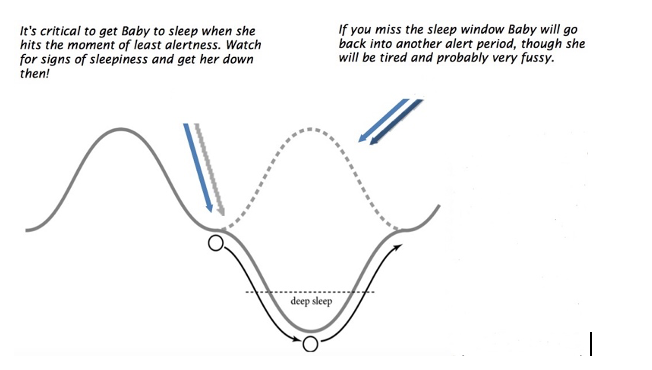
Sleep Cycles By Age
To help understand what’s expected in terms of baby sleep, here is a breakdown of newborns and infant basic awake and sleep times by age:
- Weeks 0-2: Baby is awake for a maximum of 30 minutes. This is the sleepy newborn stage where most of your newborn’s time awake is spent feeding. You might even have to prompt them to try to wake up during a feed.
- Weeks 3-8: Awake for a maximum of 45 minutes. You’ll notice baby is more alert as they approach week 8. White noise, babywearing and giving a pacifier to help your baby sleep are all fine to do because at this age your help to get and stay sleep is truly needed.
- Weeks 8-12: Baby’s awake time is eventually 60 minutes. You might need to help your newborn with napping if they wake up after 10-15 minutes by giving a pacifier or patting. Please know you’re not instilling bad habits. It’s developmentally appropriate that your baby needs a little help because the system that makes melatonin is not mature yet.
- Weeks 12 – 18: We’re getting to the 90 minutes of awake period! Baby is even more alert and may need help getting and staying asleep. Remember it’s okay to allow baby to play independently in the crib as long as they are happy. If you want them to sleep through the night eventually, there’s no need to rush them out of the crib when they wake up if they’re happy there.
- Weeks 18 -24: Your infant is awake for 90+ minutes and you’re seeing longer and fewer naps. Naps will vary in length, especially if you’re out and about during the day. If you’ve begun nighttime sleep training these naps become even more consistent.

Ultimate Guide to Baby Sleep Training – Safe Sleep and Minimizing the Risk of SIDS
Before we can address sleep training an infant from 4 months to one year old, we must be sure they are in a safe sleeping environment. Here’s what that means:
1.Back to Sleep: Always place babies up to age 1 on their backs to sleep. This is true for naps as well as overnight sleep.
Why Back to Sleep?
- As baby rebreathes already exhaled air, they lower the oxygen level in the body, while the level of carbon dioxide rises.
- We now know some babies might be born with an arousal enzyme that reduces their ability to wake or respond to their environment. Being on their tummies is a situation where this arousal response may be impaired.
- “When a baby is in the back sleeping position, the trachea lies on top of the esophagus. Anything regurgitated or refluxed from the esophagus must work against gravity to be aspirated into the trachea.” This means fluid pools in the trachea causing additional choking risk.
2. Flat, clear surface: Place baby on a firm, flat surface clear of toys, crib bumpers, blankets & other items. This means no crib wedges, sleep positioners or other items marketed to help infants sleep more soundly. Keep baby’s airways clear without any risk of the head lowering and restricting airflow by placing them in the supine position.
3. Room Sharing: Keep baby in the same room, but not the same bed fas you for at least the first 6 months of life.
4. Avoid Smoking: in the home and around baby. There’s no risk-free amount of smoke for your baby. This includes secondhand smoke.
5. Use a fan: Air circulation minimizes the risk of SIDS by 72%. You can use a ceiling fan or a portable oscillating fan. Both will work to keep the air flowing and reduce the risk of re-breathing air that has already been exhaled with carbon dioxide
6. Breastfeeding: If you can, nursing your newborn for at least 2 months has been shown to reduce the risk by 50%. This counts for milk given from a bottle too. The reasons are because breastmilk promotes brain growth, builds up the immune system and reduces instances of reflux, which keeps airways clear.
7. Vaccinate: Immunizations are proven to reduce to risk of SIDS.
8. Don’t let baby overheat: Dress appropriately for the temperature.
9. Give a pacifier: As the AAP has noted sucking on a pacifier requires forward positioning of the tongue, thus decreasing this risk of oropharyngeal obstruction. Don’t use a string or other attachment device when using a pacifier.
10. Avoid products that go against safe sleep guidelines: While they can still be found at many resellers, inclined sleepers have been banned for sale. The Consumer Product and Safety Commission (CPSC) ban affects rockers, pillows, nappers, wedges and sleep positioners. This ban took effect in 2022. Infants should not be put in these for sleep.
2022 Updated Safe Sleep Recommendations
No Weighted Sleep Sacs or Swaddles – The 2022 Safe Sleep Guidelines by the American Academy of Pediatrics also address weighted sleep sacs and weighted swaddles stating that Weighted swaddles, weighted clothing or weighted objects on or near the baby are not safe and not recommended.
Swaddling with a non-weighted blanked is still recommended to help newborns stay comfortable, but there’s no evidence that swaddling is a SIDS deterrent.
No to Commerical Devices Claiming to Reduce the Risk of SIDS – The AAP also specifically calls out cardiorespiratory monitors and other commercial devices that claim to reduce the risk of SIDS or other sleep-related deaths. Not only is there no evidence to support these product claims but the use of products claiming to increase sleep safety may provide a false sense of security and complacency.
In other words, you should avoid monitors and cribs that claim they will buzz or ring if baby’s breathing stops or heart rate lowers.
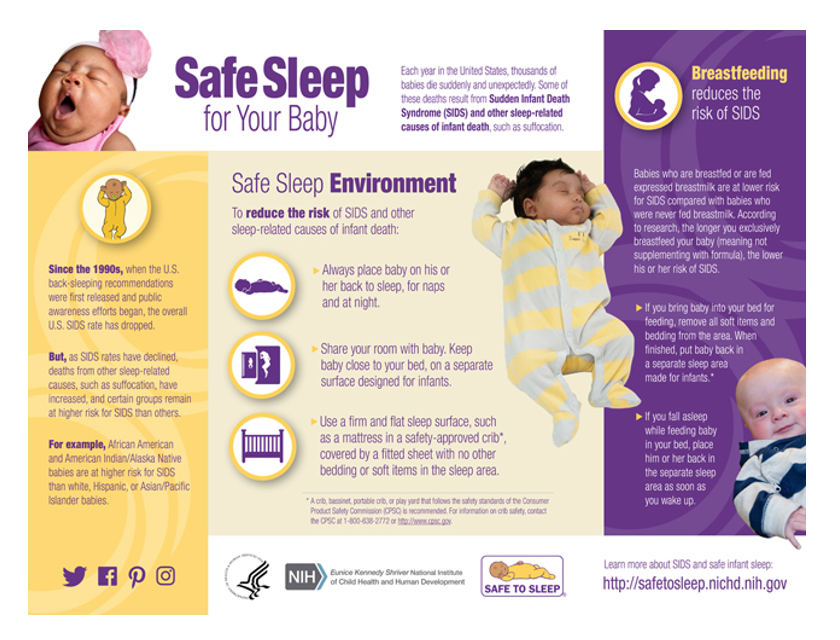
Ultimate Guide to Baby Sleep Training – Getting Baby on a Schedule and Sleeping Through the Night
Now that we’ve addressed when to sleep train and safe sleep we can move on to actually doing it!
There are 4 basic steps to sleeping through the night:
- Get pediatrician’s okay that baby is able to sleep 6 or more hours without needing to feed.
- Give consistent daytime feeding of 4 feeding sessions during the day of 6-7 oz per feed, plus a dreamfeed around 10pm.
- Wean overnight feeds while increasing daytime feeds.
- implement formal sleep training using the Slingshot Method
Step 1, Pediatrician’s Okay: is pretty self-explanatory! Once they say your baby is physically and developmentally able to sleep long stretches without feeds you can move on to the next steps. This is important because we want to set your baby up for success but also because *you* need to know you’re making the right decision.
Step 2, Consolidating Feeds into Consistent Daytime Feeding Only (You’ll see Steps 2 and 3 naturally happen together!)
The next step to sleeping through the night is taking your baby’s hunger off the table. We need to ensure your baby is taking larger, consistent feeds during the day and not waking out of genuine hunger overnight. If babies are hungry, we have to feed them! We can’t “sleep train” them not to be hungry! This means 4 consistent feeding sessions of milk and solids (when they begin solids) every 4 hours with one last “dreamfeed” around 10:00p.
With 4 feeding sessions of 6-7 ounces plus a final dreamfeed, your baby is getting enough calories to sleep longer than 3 hours through the night. In other words, 28-32 ounces should be enough so your baby doesn’t waking out of hunger. Your baby might still wake out of habit, and not hunger.
Eating larger meals at predictable times means baby will also anticipate rest at predictable times. This is the natural transition to having a “night” and a “day” instead of the 24 hour schedule of eating a bit, sleeping a bit, eating a bit, sleeping a bit. As our night nannies and postpartum doulas like to remind parents: We’re not taking away ounces at night, we are simply repositioning them to be taken in during the day.
How to consolidate feeds and transition baby to a 4 hour feeding schedule:
Upon waking in the morning, give as much milk as baby wants at feeding time.
For the next feed, work on holding off for as close to the 4 hour mark as possible. THIS WILL BE A GRADUAL PROCESS and may take 1-2 weeks.
We of course do not want baby to get to a state of frenzied hunger so it’s recommended to hold off feeds for 3 hours and 10 minutes on these first tries, then work up to 3 hours and 20 minutes and so on. Just push the feeding time up by a few minutes each day.
You will not see a perfect 4 hour schedule emerge on the first day. It will take 5-7 days of consistently working toward 4 hour feedings, before you see a 4 hour feeding schedule. You’ll see baby is able to go longer and longer stretches with each feed until after several days, they’ll be doing the larger 6/7 ounce feeds every 4 hours.
Step 3, Weaning Overnight: The good thing about Step 3 is that it’s probably happening at the same time as Step 2! While you’re transitioning to feed only during the day, baby will still wake up during the night. This is because the full transition time will take several days and we have not yet addressed formal sleep training. During this time you’re still doing your normal overnight feeds but gradually giving less and less overnight.
To wean overnight, simply give ½ ounce less in the bottle over the course of 2-3 nights. It’s okay to use a pacifier to help baby go to sleep during this time.
For example, if baby usually takes a 4 ounce bottle twice overnight do this:
Night 1: 3 1/2 ounces at each feed. Give pacifier at end of feed if needed.
Night 2: 3 1/4 ounces at each feed. Give pacifier at end of feed if needed.
Night 3: 3 ounces at each feed. Give pacifier at end of feed if needed.
You can probably stop after 3 ounces and just give the pacifier or rock baby back to sleep but you can continue the weaning as long as you are comfortable.
Once we know baby does not need to eat through the night, and of course there are no other physical ailments that are outside of your infant’s control waking them, we can help them sleep through the night.
What’s a “Dreamfeed”?
The term dreamfeed was coined by the widely respected Baby Whisperer newborn advice books. It means to simply feed your newborn or infant while they are in a sleeping state. This is usually 3 hours after baby has gone to bed at 7pm, so in the 10pm hour. The reason it’s recommended at 10:00 is because you are still awake but your baby hasn’t yet naturally awakened out of hunger.
If you hold bottle/breast to baby’s lips they will instinctually drink if they’re hungry and stop when they’re satiated. Taking in these few ounces allows them to sleep through the time when they would typically wake up out of hunger. So you’re feeding them before they wake out of hunger so you can both get a long stretch of sleep.
In other words, feeding baby before you go to sleep means that you might eliminate one of the middle-of-the-night feeds. Because your baby is full and comfortable in the 10pm hour, they’ll sleep longer while you’re sleeping.
You can do quick diaper change after the feed too just to be sure your infant is comfortable and clean! Our night nanny and postpartum doula team loves using wipe warmers for the dreamfeed. A nice warm wipe can help keep babies calm. Why startle them awake with a cold wipe if you don’t have to?!
Why Does A Dreamfeed Work?
Without a dreamfeed, a baby who typically feeds in the 7 PM hour may awakens naturally from hunger at midnight, 1 AM or 2 AM. Giving a feed in the 10:00 hour allows parents to head off this hunger and may allow baby to sleep longer, usually until 4 AM. By giving a feed at 10 PM, instead of waiting to see when baby naturally wakes to feed, we are shifting baby’s asleep hours to match parents, so parents get a long stretch of sleep themselves.
The other reason for a dreamfeed is that during sleep training, we want to take the question of whether or not baby is hungry off the table. The extra ounces given at the dreamfeed assures parents that their baby is properly statiated and able to sleep for 6-8 hours.
The addition of these few extra ounces will eliminate the physical need for baby to awaken for the first overnight feed. This is because we’re taking waking from true hunger out of the equation. As your infant gets older and able to physically sleep 10-12 hours without needing to eat (which is only decided on by families and their pediatrician) the dreamfeed provides that final feed of the night to take babies through to their natural wake up time in the morning.
How a typical dreamfeed schedule works:
6:30 or 7:00 PM: Baby’s last feed before baby’s bedtime
10:00 PM: bring bottle/breast to baby while baby is still asleep (dreamfeed)…this is before your bedtime
10:20 PM: quick diaper change and back to sleep
While certainly not a necessity, the dreamfeed is a simple extension of baby’s natural 3 hour feeding cycle. It works whether parents are breastfeeding or formula feeding.
Sleeping through the Night – The Wind Down Routine
When we think of “sleep training”, we usually imagine what we’ll do when baby wakes in the overnight hours. If you’re jarred awake at 1:30am do you go in and soothe baby? Give them a few minutes to work it out on their own? But in reality, if your baby can get to sleep on their own at bedtime, usually in 7:00- 8:00pm hour, then they can get themselves back to sleep when they wake overnight. The good thing about starting actual sleep training at bedtime is that you will also be prepared for the process instead of being startled in the middle of the night.
To help a child fall asleep on their own at bedtime, establish (or continue!) an average 20-30-minute wind-down routine. The consistency of having the same 2-3 predictable and calming elements before sleep each night will help your baby switch gears and anticipate sleep. This helps them achieve the coveted “drowsy but awake” state, where they’re still awake but receptive to sleep. A common bedtime routine is: bath, bottle, books then bed.
Remember the visual above? You’re putting them down to sleep when they’re at the bottom of the curve and therefore most ready to go from awake to asleep. So, once the wind-down is over and baby is sleepy, it’s time to place them in the crib to get to sleep independently.
This means they must manage their own process of falling asleep without the use of a pacifier, falling asleep while feeding, and being rocked to sleep. These actions are managed by us parents, and if babies are going to be sleep trained, they need to find their way to sleep on their own- without our intervention. So when they awaken through the night, they can use the tools they control to get back to sleep…not be dependent upon us to give the pacifier etc.
Ultimate Guide to Baby Sleep Training – The Actual Method
There are lots of sleep training methods out there but they all have one thing in common- the parent eventually cannot intervene. Sleep training or sleep coaching as it’s sometimes called, usually involves crying as a transition from being awake to asleep and each method essentially comes down to where you want to be positioned to hear the baby cry. Next to the crib? (The pick up/put down technique) In the hall? (cry it out) Popping in every few minutes? (Ferber).
None are right or wrong, we’re just making the point that sleep training methods aren’t really all that different from your baby’s point of view.
The formal sleep training technique our night nurses use is the Slingshot Method where you stay in the room while baby learns to go to sleep. You may choose another method at this point though and that’s fine! The important part is that the path has been properly laid so you know baby isn’t waking from hunger or something else outside of their control.
Here’s How the Slingshot Method of Sleep Training Works
- During the first few nights, stay next to the crib and reassure with touch or your voice. You can try patting, singing or the shhhh sound, but try not to pick baby up. You’re showing that you are there to comfort and support, but your baby is the only person who truly knows how to get to sleep. It’s okay to sleep in the room during the first nights if that makes you more comfortable.
There will likely be 7-10 minutes of crying especially if this is baby’s first time without the pacifier. And yes, it might be silly to soothe with your voice if they are very loud so you don’t have to! If you feel after 10 minutes or so that the crying is escalating and getting worse, it’s okay to try the formal sleep training again later in the night.
- During the next few nights, sit (sleep) a little further across the room and just soothe with your voice. You can get up and reassure with touch but try to wait a bit longer in between each soothing time. During the next few nights, sit even further away from the crib near the doorway and soothe with your voice. Eventually you’ll be out of the room altogether. The object is to slowly and gradually do this so that it is a gentle change from “I get help” to “I do this on my own” for your baby.
- If baby wakes up between 10p – 5:00am, you can wait 5-7 minutes before going in. Once babies are able to fall asleep independently at bedtime, they’re able to soothe back to sleep during a night waking. But if you do want to check on baby, remember not to pick them up, just reassure with touch or your voice.
Your baby’s natural wake up time is when your baby wakes for the day rested and happy. Often, 5am is a natural wake up time.
If this isn’t ideal, just remember that it’s not forever. Also- you don’t have to go rushing in to get your baby simply because they’re awake. If they are babbling or trying to scoot around the crib in the morning, it’s perfectly fine and healthy to let them play independently as long as they are doing so happily. After all we want the crib to be somewhere they look forward to being!
Consistency is Key
The most important thing to remember in helping a baby sleep through the night is keeping consistent. If you are sure, that your baby isn’t hungry, sick, teething or has another need where your comforting is needed, the fastest way to get your baby to sleep through the night is by sticking to the sleep training method you choose.
For example, if baby cries for 10 minutes and you give a bottle, they’ve learned that crying for 10 minutes = bottle. This puts you back at the beginning of the process and confuses your infant.
Sample Sleep Schedules For Babies
Now that you have the tools, here are some sample feeding and sleep schedules for babies.
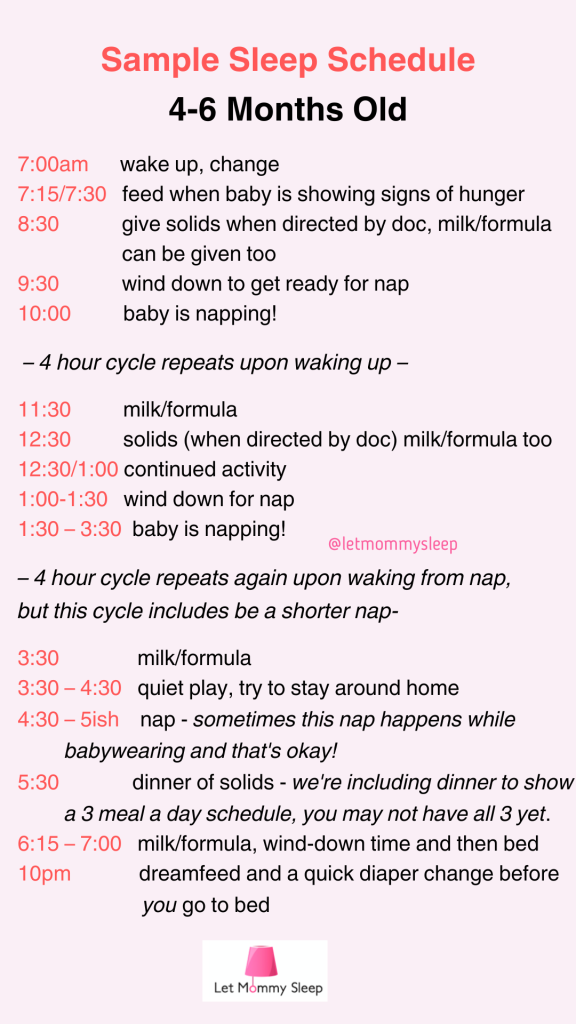
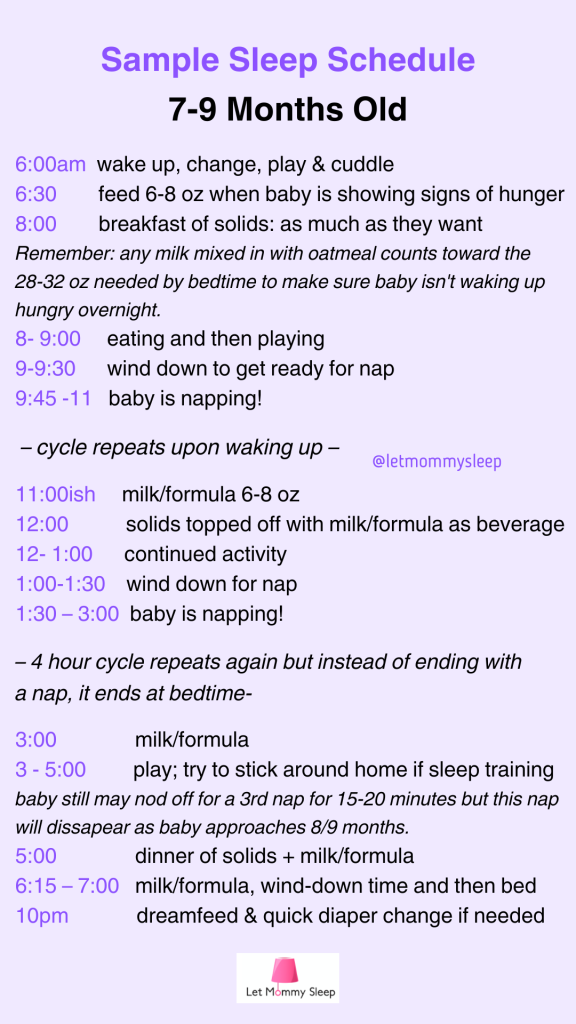
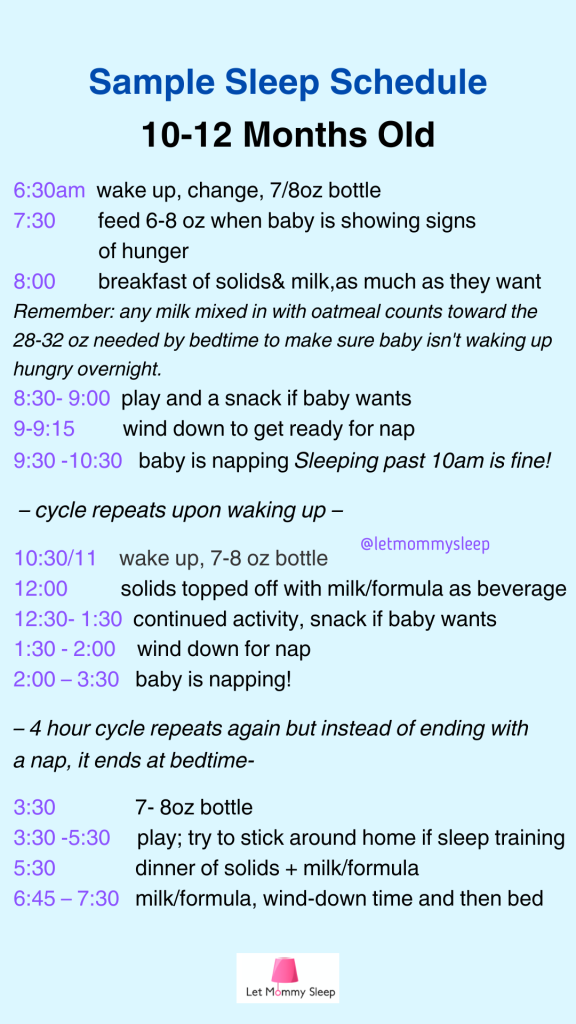
Things to remember about these Infant Sleep Schedules:
– THESE ARE JUST EXAMPLES. It is FINE if your schedule differs. If this feels forced to your family, it’s okay to wait til trying a schedule or not use a schedule at all.
– Sample schedules are a way for you to picture and work toward a start and end to the day so there is a long stretch of sleep overnight.
– We’re using 7:00 am, 6:30 and 6:00am as example starting points. If your baby wakes earlier or later, you can adjust the written schedule to start at your baby’s wake-up time.
– In months 7 and 8, babies typically drop the third daytime nap that usually happens in the 4:00 hour so there will be inconsistency in the later hours. This is just your baby naturally consolidating their awake and asleep times into longer blocks.
Ultimate Guide to Baby Sleep Training – The Four Month Sleep Regression
We can’t talk about sleep training without mentioning the infamous 4 Month Sleep Regression. Registered Nurse and Newborn Care expert Pam Jones explains…
Newborn babies only have 2 stages of sleep; stage 3 and REM, and they spend about half their sleep in each stage. At around the third or fourth month, there’s a reorganization of sleep, as they embrace the 4-stage method of sleep described above.
- REM and Waking Up – When the change to the 4 stage method of sleep takes place, baby moves from 50% REM sleep to 25% in order to make room for those first two stages. Although REM sleep is light, it’s not as light as the 2 new stages of sleep they’re getting used to. With more time spent in lighter sleep, there’s more of a chance that your baby will wake up.
Waking up is absolutely natural, and we all continue to wake up three, four, five times a night into adulthood. As adults this usually happens so quickly that we don’t even remember! But a 4 month old who’s fallen asleep at the breast and then wakes up alone in a different location is rightfully startled and probably won’t go back to sleep without your reassurance.
- Pacifiers and Soothing – The other major contributor to this 4 month regression, is that up until this point, your baby is used to going to sleep with the interventions of a pacifier, being rocked or breastfed. This is perfectly appropriate for newborns and young infants. At 4 months however, baby may need new ways to get back to sleep after the initial nodding off because the lack of a pacifier or being rocked when they wake up means that baby’s not able to get back to sleep again without your “outside help”. Cue the crying because baby can’t grab a pacifier or rock themself back to sleep.
What you can do to help your little one through the 4 Month Regression
- Dark Room – Newborns and infants are not afraid of the dark but they are responsive to light. Light tells their brains that it’s time for activity and alertness, so darkness during nap and sleep time is crucial.
- White Noise – Since babies spend so much time in the lighter stage of sleep, noises can easily wake them. White noise can help mask the sounds that might awaken your baby if quiet isn’t an option.
- Bedtime Routine – As noted above, a bedtime routine should be about 20 – 30 minutes long, and baby should go into their crib while they’re still awake but receptive to sleep. Giving a bath, then breast or bottle, books then bed gives baby time to digest and also switch gears from awake to sleepy.
Once again, our night nanny and postpartum doula team recommends talking to your pediatrician at the 4 month well check is so baby can get through this regression before formal sleep training. You’ll get reassurance that they’re now ready to follow the sleep patterns they’ll have for the rest of their lives.
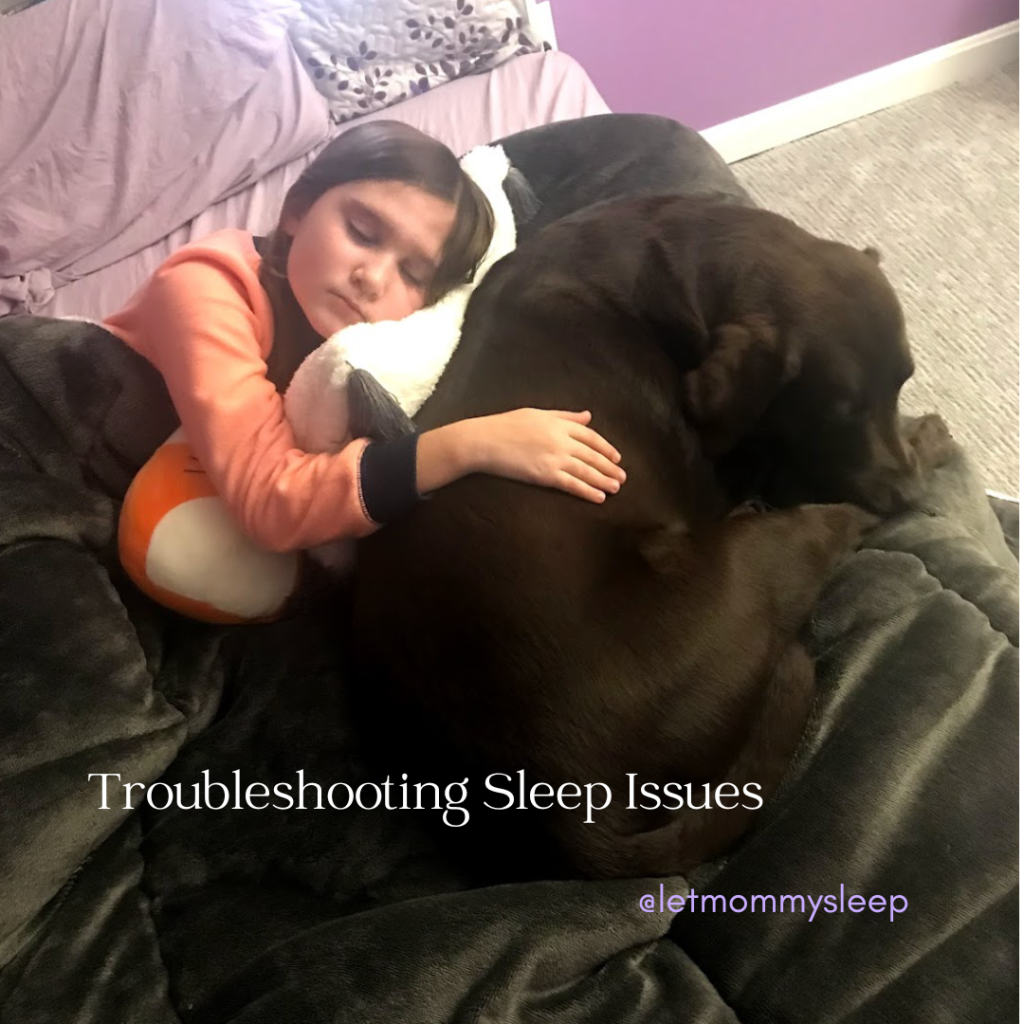
Troubleshooting Infant Sleep – Common Q and A
Will putting rice cereal in my baby’s bottle help them sleep longer?
No. There’s no evidence that shows this to be true. In fact an NIH study disproves this myth. Your pediatrician might suggest thickened formula if there’s a medical issue but this is different than using rice cereal to get a newborn or infant to feel full and sleepy.
As your baby grows and their belly can hold more, they’ll sleep longer stretches before waking from hunger. While we wait for this growth, here are suggestions to help your baby sleep soundly:
- Swaddle –swaddling keeps baby from waking up due to involuntary movements. Learn 2 swaddling techniques.
- White Noise – drown out the noises that can wake baby up
- Slow feeding with lots of opportunities to burp – hold baby upright for at least 30 minutes after feeding to be sure no gas is trapped and help them digest.
My baby has SO MUCH gas! How can I help them work it out so they can sleep?
Slow patient feeds, lots of burping and gently switching position or massaging baby to get gas out after feeding are tried and true ways to help keep baby comfortable. Here are more techniques:
- Bicycle Kicks –like this!
- If bottle feeding, use the slowest nipple flow.
- To promote good gut health, probiotics may be recommended by your pediatrician.
- Introduce new foods at breakfast time so your baby has all day to work through any gas issues before bedtime.
No matter what we do, our infant gets up way too early. How can we get them to sleep later?
Dr. Lisa Meltzer, Professor of Pediatrics says: “the internal clock is a powerful force that typically wakes young children up around the same time every morning, no matter what time they go to sleep at night.” Unfortunately, we can’t fight baby’s natural body clock by nudging them to stay up later so the best we can do is control our own environment til the early-waking stage passes. Taking turns with your partner or another caregiver to be on wake up duty won’t help your child sleep later but it will help you get rest!
Why does my baby wake through the night when I know s/he’s not hungry?
There are typically 3 reasons for this:
- Illness or Discomfort– Getting comfortable is very difficult when a person is experiencing congestion or ear infection. Laying horizontally makes the fluid in the inner ear or chest settle and this can be painful for your baby. A soiled or tight diaper might also be making your baby uncomfortable. Responding is the right thing to do in these situations.
- Teething –pain from baby’s teeth coming in is a common reason for overnight wakefulness. Teething typically begins in months 4-7. Common signs are drooling and baby putting their fingers and fists on their mouth.
- Habit – for healthy babies who have never slept through the night waking up can mean they are simply repeating the same schedule they have always had. Since baby has never sleep more than 3 hours at a time, their body might just need a gentle weaning of overnight feeds to allow them to sleep through the times they would have been feeding in the past.
When do I stop swaddling?
When a baby starts rolling onto their stomach, the swaddle becomes a hazard and should be stopped.
To eliminate the swaddle, parents can take a gradual step-down approach where we allow one arm out for several nights, then 2 arms and then eventually no swaddle at all.
How do I get rid of overnight feeds when I know my baby doesn’t need them?
Anytime we are helping baby -and well, anyone really- learn a new way to do things we have two choices: cold turkey or gradual introduction. Cold turkey certainly cuts to the chase, but the gradual approach can be less jarring for your baby. Gentle weaning means we’re giving 1/2 ounce less, or nursing for a few minutes less at each feed that happens between 10pm and 5am.
So if you baby usually takes 6 ounces, start weaning by giving 5 ½ oz for a night or 2. Then go down to 5 oz until you get to 2 ounces or so. When you take away the bottle or nipple, you can give a pacifier so baby is sucking but not eating.
If you’re nursing, gradual weaning is essential so that your body has time to adjust to not needing to make full feeds overnight.
How do I get rid of the pacifier?
Once again you can go “cold turkey” or use a gradual removal technique. Simply remove the pacifier after less and less time per pacifier session. For sleep training, it’s typically recommended to remove the paci when baby stops sucking for a few moments. You may need to repeat removing the paci several times until the pacifier is eventually not needed.
What about toddlers? How can I help my older child sleep through the night?
Helping your toddler sleep through the night is usually a matter of consistently reinforcing a new behavior. It’s perfectly normal for your little one to want to be in the big bed with you but if you need them to be in their own room, read this.
Ultimate Guide to Baby Sleep Training – There’s More Than 1 Right Answer
Whether you’re dedicated to following an infant sleep schedule or you’re out and about without a schedule, there are a lot of ways to keep your newborn, infant and older kids happy and healthy. As long as your family is safe, harmonious and healthy, the parenting you’re doing is right.
Even if you follow this blog or any sleep advice exactly as it’s written, your newborn, infant and toddler will still cry. They will cry to a point where you might experience frustration that scares you. If this happens it is okay to put your baby down in the crib or other safe space and walk away for 15 minutes. You can go back in when you’re more calm. And maybe your child is more calm too. If you’re concerned about baby’s crying or health, please contact your pediatrician.
Our infant sleep plans were written by Registered Nurses and Night Nannies using the guidance of our Medical Advisory Board. They’re not intended to be used as or replace medical advice. Any kind of sleep training or change to your baby’s feeding and sleep habits should only happen under the direction of your child’s primary care physician.
If you’re concerned about your own crying or health you can reach out to 1-833-TLC-MAMA (1-833-852-6262).
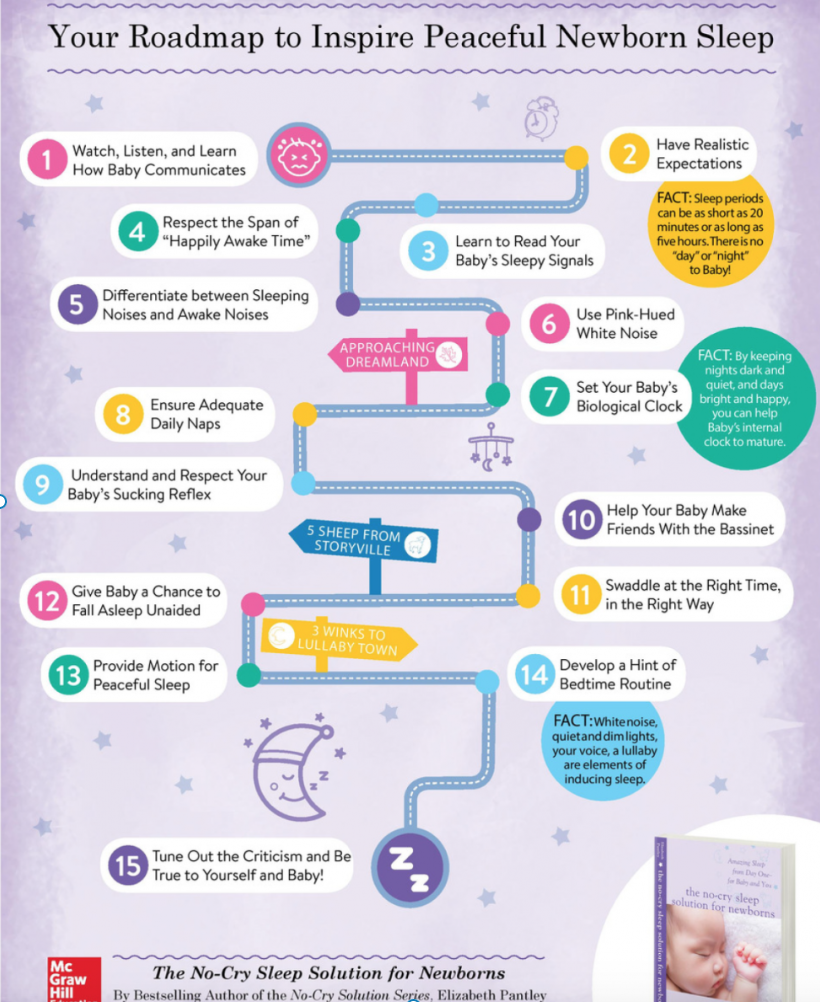
Categories
- Baby Care Classes
- Baby Care How-To's
- Baby Sleep
- Family Activities with Baby
- Feeding
- Franchise & Company Info
- Hiring Help
- Our Favorites
- Postpartum Health
- Safety & First Aide
- Twins & Multiples
- zArchives
